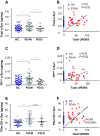α-Synuclein in blood cells differentiates Parkinson's disease from healthy controls
- PMID: 31742923
- PMCID: PMC6917335
- DOI: 10.1002/acn3.50944
α-Synuclein in blood cells differentiates Parkinson's disease from healthy controls
Abstract
Objective: To determine whether blood cells expressed α-Syn can differentiate Parkinson's disease (PD) from healthy controls (HC).
Methods: The concentrations of α-Syn were determined in samples of blood cell pellets using a quantitative Lipid-ELISA assay. In addition, the levels of total protein, hemoglobin, iron and H-ferritin were determined. The study includes samples from the Biofind cohort (n = 46 PD and 45 HC) and results were validated with an additional cohort (n = 35 PD and 28 HC).
Results: A composite biomarker consisting of the concentrations of total α-Syn, proteinase-K resistant (PKres ) α-Syn and phospho-Serine 129 α-Syn (PSer 129), is designed based on the analysis of the discovery BioFIND cohort. This composite biomarker differentiates a PD subgroup, presenting motor symptoms without dementia from a HC group, with a convincing accuracy, represented by an AUC = 0.81 (95% CI, 0.71 to 0.92). Closely similar results were obtained for the validation cohort, that is, AUC = 0.81, (95% CI, 0.70 to 0.94).
Interpretation: Our results demonstrate the potential usefulness of blood cells expressed α-Syn as a biomarker for PD.
© 2019 The Authors. Annals of Clinical and Translational Neurology published by Wiley Periodicals, Inc on behalf of American Neurological Association.
Conflict of interest statement
Authors S.A.E., J.G., M.P., P.A. and D.A have no conflict of interests. R.S. owns patent PCT/IL2014/050191: An ELISA method for a sensitive detection of alpha synuclein, consisting of its phospholipids binding properties.
Figures



References
-
- Comi C, Magistrelli L, Oggioni GD, et al. Peripheral nervous system involvement in Parkinson's disease: evidence and controversies. Parkinsonism Relat Disord 2014;20:1329–1334. - PubMed
-
- Postuma RB, Poewe W, Litvan I, et al. Validation of the MDS clinical diagnostic criteria for Parkinson's disease. Mov Disord 2018;33:1601–1608. - PubMed
-
- Zaidel A, Arkadir D, Israel Z, Bergman H. Akineto‐rigid vs. tremor syndromes in Parkinsonism. Curr Opin Neurol 2009;22:387–393. - PubMed
-
- Braak H, Del Tredici K. Neuroanatomy and pathology of sporadic Parkinson's disease. Adv Anat Embryol Cell Biol 2009;201:1–119. - PubMed
Publication types
MeSH terms
Substances
Grants and funding
LinkOut - more resources
Full Text Sources
Medical
Miscellaneous
